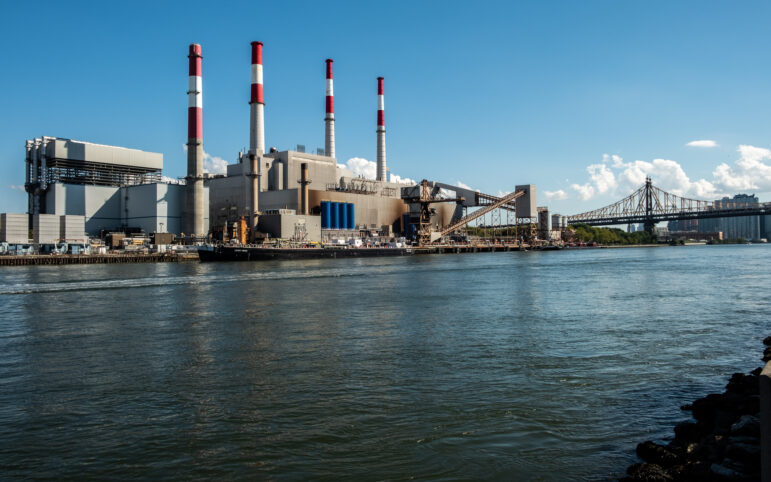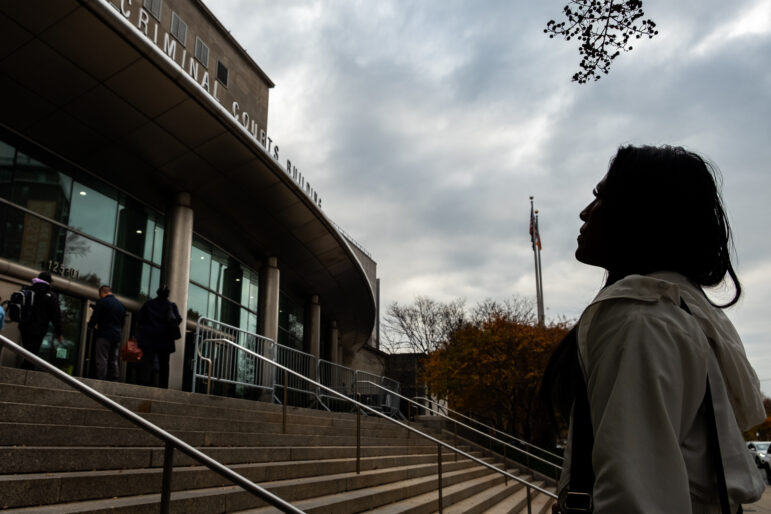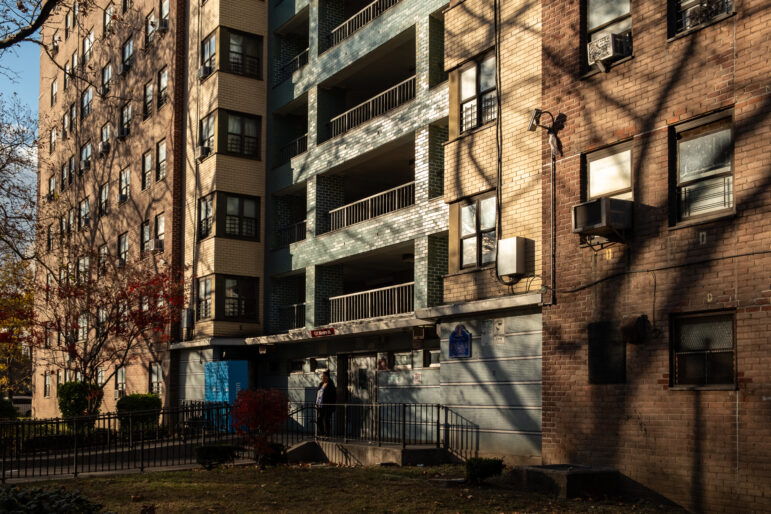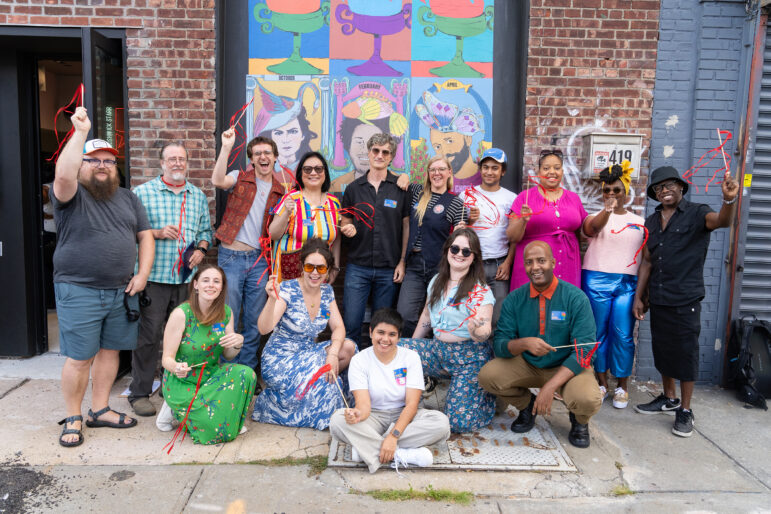
Photo by: Marc Fader
First Houses, on the Lower East Side, is where public housing began in the United States. New York is the only city to create its own public housing, and New York is one of only four states to have its own public housing program, on top of the federal one.
Eleanor Roosevelt is not on Isaac McQueen’s mind right now. Nor are all the politicians or dignitaries who were present on a cold December day in 1935 when First Houses opened—the first public housing development in the United States, designed to help low income residents escape the squalor of the city’s run-down tenements.
McQueen thinks only of trying to make it up the stairs as he slowly shuffles to his fourth floor apartment. There are no elevators here and he concentrates as he swings his legs on step after step, cradling his crutches in one hand and the railing in the next, slightly wheezing. A veteran of the Cold War (he guarded missiles in Washington state), he now is engaged in a different kind of fight: a 15-year battle against the New York City Housing Authority (NYCHA) over a perpetual leak coming through his kitchen ceiling.
McQueen has lived in First Houses since October 24, 1994. The man living in what became his apartment moved into another on the first floor that was originally meant for McQueen. McQueen was instead moved to the fourth floor apartment, where the reason for the previous tenants’ move became immediately apparent. “He’d requested to be moved out, for the same reason,” McQueen says, “the leak.”
The feeling among some residents in First Houses falls somewhere between pride and worry about the historic landmark that they call home. Lashawna Kelly, who lives in another of the eight buildings comprising First Houses, is fighting her own battles against leaks and cheap, falling doors. Violet Campbell wages war almost daily against the mice that try to creep through the cracks in her deteriorating kitchen floors, while Israel Alvarado tries to contain the mold that hides behind the tiles in his mother’s bathroom. And then there’s McQueen, whose 15-year ordeal has taken a toll on his kitchen and patience.
A rich history
First Houses opened in 1935 to great fanfare. Thousands of New Yorkers lined the streets to celebrate the hopeful demise of dank, rat-infested tenements. The Houses were completely new apartment buildings and were to represent the embodiment of the American dream: affordable and decent housing for all. Mrs. Roosevelt dedicated the new development, with Mayor Fiorello LaGuardia standing by her side, the newly built First Houses cheerfully in the background.
Andrew Berman, Executive Director of the Greenwich Village Society for Historic Preservation (GVSHP), believes that the First Houses are one of the most important and significant landmarks in the city. “They are such an important forerunner of building type that so affected New York City that there are few places that I can think of that are more significant landmarks as they relate to the life of New Yorkers,” he says.
As public housing multiplied from the 1930s through the 1960s, many housing authorities around the country became fiscally insolvent and were mismanaged. “New York City was lucky,” Bach says. “New York has the largest public housing program in the country. One out of every fourteen units is located here in New York. Compared to many other large cities, New York’s public housing has been relatively well-managed by NYCHA.”
When they first opened, the First Houses stood in stark contrast to the tenement buildings that were previously on the same land. According to the First Houses landmark designation report, new residents would have been thrilled that there were new indoor bathrooms, electric refrigerators, gleaming wood floors and even a community laundry room for each building—with electric washing machines. Between 3,000 and 4,000 applicants competed for the only 122 apartments, not a surprise for a city reeling from the Great Depression.
Funding fallout
Now, these same apartments are more than showing their age. The once sparkling floors are now worn and some residents complain that the plumbing system, a novelty when they were installed in the 1930’s, now leaks in many of their apartments.
“We have typical problems: heat, NYCHA isn’t so quick to come out for repairs,” says Kelly. “My refrigerator light is out and now the fridge is leaking all over the floor.” Kelly is proud of First Houses’ designation as a city landmark and finds it important to preserve its rich legacy. But, she thinks NYCHA workers often don’t share the same sentiments. “They’ll start paying attention if a resident gets hurt and sues them,” she says. “If the door is broken, they don’t get fixed or they get replaced with cheap ones. That messes up the structure of the building. Then, they fall and mess up the doorframes.” Kelly shrugs. “But something’s you have to deal with when you’re living in public housing.”
Some residents feel that the problems at First Houses have begun to symbolize the troubles facing NYCHA in general.
NYCHA, which operates 180,000 units of housing in the city, exists on two different streams of federal funding. The first, operating funds, is supposed to cover the day-to-day maintenance concerns of the developments, while the second, capital funds, purportedly pays for long-term improvement initiatives for developments.
But neither fund has been providing sufficient money to address problems in NYCHA’s aging buildings, so the authority is sometimes forced to react to the needs of the developments only when things become critical.
This approach, according to Community Service Society hosing analyst Vic Bach, is largely ineffective. “Things are not getting better,” he says. “They’re getting worse. Except for those developments where NYCHA might be concentrating its capital improvements.” The NYCHA was recently a recipient of $423 million worth of capital funds from the stimulus package. However, these funds are being used to fix up what were previously state and city developments, of which First Houses is not one. (CSS owns City Limits.)
With First Houses being the oldest of the NYCHA’s housing developments, it’s bound to have some of the worst problems.
NYCHA is trying to address some issues at the development. An official statement explains that “NYCHA is currently developing a comprehensive Five Year vision—a strategic Plan to Preserve Public Housing that is an unprecedented collaboration with partners in New York and across the country. It will serve as a vital roadmap for addressing our current maintenance and repair backlog, as well as other challenges in the future.”
“In the five year plan, First Houses is scheduled for entrance work this year that includes installation of an electromagnetic lock and intercom system to the front entrance gates. The work is scheduled through 2015,” the statement continues.
Losing patience
Heyward Walker, a member of the First Houses tenant association, feels that this work can’t come soon enough. Walker has lived in First Houses for the past eight years. Two years ago, he and other residents formed a new tenant association to deal with resident’s most pressing issues. “Ain’t nothing was getting done,” he says. “When we call them for something, they give us two weeks to come and fix it. Or more. But if they want their money for their rent, they’ll hurry up knocking on your door. Telling you, what happened to your rent? But when people need something fixed, it look like they take their sweet time. It’s not right.”
McQueen may understand this best. He has filed this year what he hopes will be his last lawsuit against the NYCHA. A court-ordered inspector’s report from July 27, 2010 documents evidence of a previous leak in the southeast corner of McQueen’s living room, a current leak in his kitchen and the need for new plaster and paint all over his apartment. McQueen had already filed a complaint with the Division of Code Enforcement, after his court-ordered reparations were not honored after 30 days. And on November 10, 2010, McQueen’s last court date, the leak was still occurring sporadically.
The water is not just an aesthetic problem. Used to using his crutches for support, he once tried to lean on his kitchen cabinets for balance, only for them to fall and he with them. “They were so damaged by water leak,” he says.
Looking up at his kitchen ceiling he looks grave. “This is the third time since I’ve been here that this ceiling has fallen down. And you can see, its getting ready to fall down again.” His living room ceiling also fell down at one point due to another leak, the plaster coming down with a violence that troubles him. “I could have died if I was there.”
From the outside, looking in
The problems associated with First Houses are not immediately obvious. The residences still boast a beautiful exterior. The buildings are made of bricks, with the doors and windowsills painted an emerald green. American flags and flowerpots grace the front of the buildings, making them appear less as housing projects, and more like co-ops. Politicians and city officials often use the First Houses for publicity, praising the development for continuing to be the symbol for affordable public housing.
First Houses tenant association president Maria Nazairo has lived there for 40 years and says when she first moved in, First Houses was the ideal public housing development to live in. But years of neglect have now taken its toll. She believes the development’s exterior look is deceiving. “Oh I tell them,” she says. “’The outside is gorgeous! There’s nothing wrong. The inside is what we have to work on.’”
Walker agrees. “Anytime someone comes over,” he says, “They be busting their [butts] trying to clean the outside because that’s the only thing that they see. But they need to check the inside and see what’s going on with the people who actually live here. ” Currently, there are nineteen open Building Code violations on First Houses, which have been opened from 1975 to now.
McQueen says his concerns are not just about his own living space, but the building’s historic exterior as well: “So my concern really is that there’s going to be irreparable damage to this entire building if this water leak continues.”
Ironically, that would be the only way First Houses’ landmark designation could force more attention to tenants’ concerns: if the outside is affected.
“With 99 percent of the landmarks in New York City, the landmarks regulation covers the exterior of the building, not the interior,” Berman, of the GVSHP, explains. “Damage or deterioration on the interior would only trigger the intervention of the landmarks preservations commission if it affected the exterior.”
On their own
Unfortunately, according to Bach, the situation at First Houses is not just about a lack of funding with the NYCHA. “There certain efficiencies, certain ways of operation through which NYCHA could improve its response to repairs,” he explains. “NYCHA is also a 75-year-old bureaucracy so it’s got procedures that may not be as fast as any of us would like.. So, it’s not just money. Bureaucracy takes a long time to change.”
Indeed, too long for some residents to wait. Israel Alvarado has had to fix a lot of the problems in his elderly mother’s apartment himself. A recent example was a hole in the bathroom wall that needed repairing. Instead of waiting on the NYCHA more, he decided to patch it up himself. He also worked on the leaks in the bathroom. “I had to fix this years ago,” Alvarado says. “NYCHA didn’t do it, I just fixed it.
Violet Campbell, who lives on the first floor of one of the residences, daily combats pests in her apartment. “The floor is so messed up, where it’s disintegrating, where the mice are coming up out of the floor up to my apartment,” she says. “I had to put aluminum down, to tape it down on the floor so the mice wouldn’t be coming up in the apartment. I understand it’s a landmark, but they need to make some type of adjustment.”
With additional reporting by Reinhard Cate








